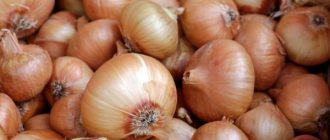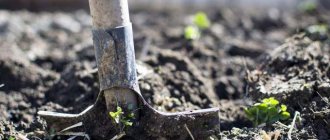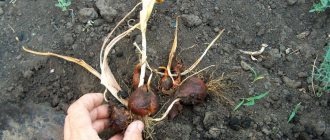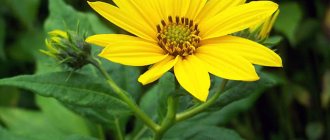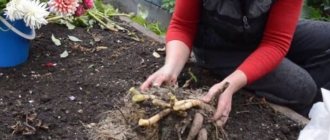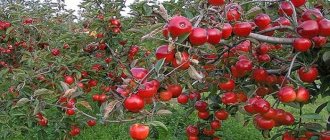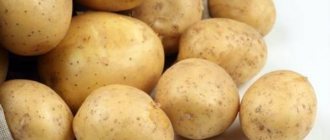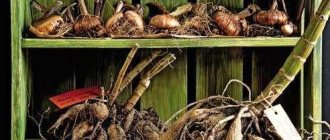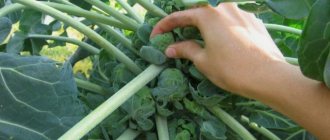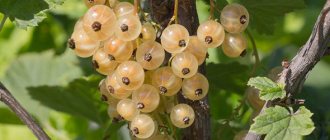Home » Miscellaneous » Jerusalem artichoke – when to harvest
Gardeners who know such an amazing plant as Jerusalem artichoke do not always know exactly when to dig it up. The problem in determining the time of harvest is caused by the fact that Jerusalem artichoke itself is a natural gift with unusual properties. What this means will be explained further.
When growing Jerusalem artichoke, it is very difficult to determine when to harvest. The fact is that the earthen pear is absolutely unpretentious. It can be perfectly preserved in the ground even in very severe frosts. This means that the gardener may not harvest at all before winter. Then, if necessary, he just needs to take a shovel, go to the site and dig up the required number of tubers. And at the same time, you can be sure that the Jerusalem artichoke will fully retain its qualities.
It’s also an interesting fact that Jerusalem artichoke’s tubers can be used as food not only. Even its green part is suitable for consumption. Of course, most of it is given to livestock. If you want to provide livestock with a sufficient amount of vitamins, you need to harvest in October. But, again, this concerns not tubers, but greens.
But when should you dig up Jerusalem artichoke if you want to enjoy its wonderful-tasting tubers? It’s worth understanding this in order to understand exactly at what point harvesting will be the most successful. As noted right away, there are several approaches to collecting Jerusalem artichoke. And everyone has their own strengths.
The importance of timely harvesting
When is the best time to dig up Jerusalem artichoke tubers for food? It is important to harvest root vegetables in a timely manner so that they have the best taste and sufficient vitamins. The most suitable time for collection is the second half of October - the first half of November.
The later the harvest is harvested, the larger the fruits will be and the greater the concentration of nutrients will be contained in the tubers. If you dig it up earlier, the nutritional value of Jerusalem artichoke will decrease; not all useful substances will have time to pass into the fruit and will remain in the green part of the plant.
How to dig up tubers correctly
Harvesting is a rather labor-intensive process. In good soil, Jerusalem artichokes grow with very tall stems, which can make the process difficult. Therefore, you need to first cut the stems, leaving 20-40 cm to provide nutrients.
Jerusalem artichoke fruits
Rules for digging Jerusalem artichoke:
- The plant is dug using shovels (it is not advisable to use pitchforks in frozen ground)
- Jerusalem artichoke is dug around the stem, at a distance of about 30 cm
- The dug plant is removed with its rhizome
- It is recommended to leave damaged fruits in the ground as recharge
- If you follow the basic rules, the risk of damage to individual tubers is reduced. It is important to remember that the largest fruits grow if Jerusalem artichoke is left for the winter. Therefore, if the harvest is carried out in the spring, you should be extremely careful, since the size of Jerusalem artichoke can be impressive.
Harvesting is a labor-intensive process that involves harvesting Jerusalem artichoke stems and then extracting the fruits from the ground.
How to determine what is ripe?
If the top of the plant begins to wither, this is a sure sign that the Jerusalem artichoke is ripe and can be harvested. The entire ripening process takes at least 120 days, and in late varieties it can take up to 150 days (how to choose a Jerusalem artichoke variety for cultivation?). This period is calculated from the moment of emergence of seedlings.
The most important phase of growth occurs in the first half of October; during this period, all useful substances move from the stem to the root. Therefore, at the end of October, it is necessary to first cut off the top part, and after about a week or two, begin harvesting.
Storing Jerusalem artichoke in the freezer
An earthen pear is stored in a cellar or basement when it is not possible to keep it in a bed in the ground. Wooden boxes are well suited for this purpose. Without clearing the soil, root crops are placed in several rows, sprinkled with sand. You can also use peat or sawdust. In this form, Jerusalem artichoke can be stored in winter even on a glassed-in loggia.
| Storage method | Shelf life |
| In a refrigerator | up to a month |
| Frozen | 60 days |
| In the ground | all winter |
| Dried | 12-18 months |
| On the balcony or in the basement | 30-60 days depending on temperature |
If you need to preserve this vegetable for a longer period, it is frozen.
- First, the tubers are well washed and peeled.
- The fruits can be chopped or left whole.
- The root vegetables are then placed in plastic containers or plastic bags and frozen.
Jerusalem artichoke can be stored in the freezer for up to 60 days, and it must be defrosted gradually in cold water.
Optimal season
It is not necessary to harvest the entire crop in the fall; it is better to leave some of it in the ground until spring. Moreover, the tubers have a short shelf life, no more than a month. It is for this reason that we do not often see it on store shelves; the complexity of transportation and storage does not allow us to see Jerusalem artichoke as a frequent guest on our table.
Attention! Jerusalem artichoke is very picky about storage conditions. No matter how hard you try, you won’t be able to preserve your crop reserves all winter; it will still deteriorate and rot.
Tubers tolerate winter well in the soil without losing their beneficial properties, and even vice versa. After winter frosts, inulin, which is part of Jerusalem artichoke, is converted into fructose, which increases the nutritional value of the root crop. After wintering, the tubers become sweeter, which is not to everyone’s taste.
Let's consider whether it is possible to collect Jerusalem artichoke tubers in the spring. In the spring, as soon as the soil begins to thaw, it will be possible to dig up Jerusalem artichokes in the required quantities. The main thing is not to leave it until new growth begins and the beneficial properties of the tubers decrease.
Tubers dug up in the spring can be immediately used for planting by cutting them into pieces (what is the time frame for planting Jerusalem artichoke?). Not only root vegetables are used for food; leaves and inflorescences of plants can be collected during the flowering period to make tea.
How to plant Jerusalem artichoke correctly
Despite the fact that the plant is not particularly whimsical, it is worth paying attention to some nuances when caring for it.
The main ones include:
- In order for the root crop to produce a good harvest, it is recommended to prepare the soil in the fall. To do this, you need to dig up the area to a bayonet depth, remove weed roots, and apply fertilizer;
- Planting of root crops should be done in early spring with soil warming to 16-18 °C;
- Planting time: first half of April or early May;
- For planting, it is better to choose tubers without mechanical damage or signs of disease. It is important to remember that the quality of the harvest directly depends on the quality of the seed;
- Before planting the beds directly, you need to dig them up again, loosen the soil and level them;
- The row spacing should be 70 cm;
- The depth of the hole for the tuber is 15 cm, the optimal distance between the holes is 30-50 cm.
It is important to adhere to these rules because of its ability to grow up to two and a half meters in height. When caring, it is important to remember that tubers prefer soils with sufficient permeability for water and air.
Step-by-step instruction
no special features or difficulties when harvesting this plant. It's quite simple:
- Cut off the top part of the plant, but not at the root, so that during further digging you can determine the location of the bush. It is better to do this a week or two before harvest, leaving the Jerusalem artichoke to ripen.
- The technology is absolutely the same as when harvesting potatoes; you need to dig with a shovel or pitchfork. It is preferable to use a pitchfork; they damage the tubers less.
- Do not dig up more than you need; collect the remaining tubers in the spring.
- If the soil is wet during harvesting, then the root crops must be dried and only then removed to a storage location.
Reference. During the flowering period, you can collect foliage and inflorescences to make tea.
Jerusalem artichoke retains all its beneficial properties until spring. It will become an additional source of vitamins and minerals when it is especially needed.
Our experts have prepared interesting articles for you about the chemical composition of Jerusalem artichoke and the difference between it and sweet potato.
What to do with Jerusalem artichoke in the fall - dig it up and leave it in the ground
Where to put the comma, decide for yourself - Jerusalem artichoke actually doesn’t care at all. Tubers are perfectly stored in the ground even at forty-degree frosts, without losing either their taste or beneficial properties. At any moment you can go to the garden with a shovel and dig up the required amount of earthen pear. We advise you to definitely familiarize yourself with the recipes for making Jerusalem artichoke.
In fact, this crop is grown not only for tubers. The plant produces excellent green mass, which is readily consumed by all livestock. Long stems with wide leaves, even with sparse plantings, shade the area so much that a rare weed can survive. Harvesting the green mass of Jerusalem artichoke begins in October - at this time there are practically no other sources of fresh greens left. It is not recommended to pick or mow the stems before - the tuber harvest may suffer. Large farms make silage feed from green mass, which is superior in quality even to corn.
The most important advantage of the plant is its absolute unpretentiousness. It is ideal as an additional food and feed crop - the soil does not need to be fertilized, there is no need to water, the weeds themselves die in the shade. Of course, if you water the plants and add fertilizer, the harvest will be even greater. An earthen pear can be planted where nothing else grows - you can be sure that there will be results.
Perennial
Wintering is provided by tubers, which contain a large amount of sugars. The shape of the tubers themselves can be varied: from pear-shaped to spindle-shaped. The flesh is white, and the skin itself is beige or yellow. The process of formation of Jerusalem artichoke tubers is identical to the process of formation of potatoes. Due to the fact that the surface of the tubers is covered with a very thin skin, Jerusalem artichoke must be collected and stored as carefully as possible. When in the ground, the tubers can withstand frosts down to -30°C, but as for external storage, it is not lower than -5°C.
Jerusalem artichoke grows beautifully and quickly. He is practically unpretentious. This allowed this plant to successfully adapt to the territory of many European countries. In addition, he managed to eliminate into the background even those species that had been cultivated for a long time. The thing is that Jerusalem artichoke produces sprouts that penetrate into the territory of plants growing nearby.
In these places, young tubers are formed and the very next year they send out their shoots, which in turn send out strong shoots. These shoots create a shadow over neighboring plants and thereby destroy them. Thus, tuberous sunflower increases the area of its existence every year.
Application of Jerusalem artichoke powder
In pharmacy chains there are several types of dosage forms with Jerusalem artichoke, one of which is powder. It is a crushed root vegetable and is used in folk medicine as a biologically active food additive or as a seasoning for dishes. You can prepare such a powder yourself, because manufacturers probably add preservatives to those on the market to extend the shelf life of the drug.
If you are prone to allergic reactions and want to have confidence in the composition, make this product yourself. To do this, select good, hard fruits that are not affected by rot, wash, peel, cut into rings and dry naturally in an electric dryer or immerse in the oven. When the rings are completely dry, grind them using a coffee grinder. In such a product, the beneficial components of the drug are preserved to the maximum extent, and the effect on the body is no different from the effect of a raw vegetable. Features of application:
- during a meal or forty minutes before;
- one teaspoon can be dissolved in one glass of boiled water at room temperature;
- If used in children's kitchens, it is better to add the powder to a salad or other dish.
Medicinal properties of earthen pear for humans
After 40 years of research into the properties of the plant - from the eighties of the last century to the present - scientists have collected enough data confirming the possibility of using Jerusalem artichoke for medicinal purposes due to the following types of effects on the human body:
- diuretic;
- vasodilator;
- reparative;
- antitumor;
- anti-atherosclerotic;
- antihyperglycemic;
- anthelmintic;
- cleansing.
There is also evidence of the ability of Jerusalem artichoke to remove stones from the kidneys and gall bladder. Some properties of the plant are especially useful for certain diseases.
In the apartment
A glazed balcony can be a good storage place if it is not possible to store the crop in the cellar. Even if the root vegetables freeze a little, their beneficial properties and nutritional value will remain the same as before.
Jerusalem artichokes are placed in wet sand, peat or sawdust. This way they can stay fresh and retain their nutritional value for up to 60 days.
For long-term preservation, this vegetable is sent as soon as it is dug up, otherwise it may begin to deteriorate from exposure to the sun and exposure to high temperatures.
Care
Care consists of watering, which needs to be done more often during drought when the soil dries out. The plant needs hilling, which is carried out a couple of times a season. This provides better air access to the rhizome. The first procedure is carried out as soon as the stems grow to half a meter.
Chickens fed Jerusalem artichoke begin to lay eggs a couple of weeks earlier than others.
At the beginning of stem growth, weeds are removed. Once the Jerusalem artichoke is pulled out, it suppresses the growth of weeds. For better development, plants are fed several times a season. During the period of emergence of seedlings, mineral compositions with a high potassium content are used. For the second feeding, you can use urea, and after harvesting, the area is fertilized with a mixture of potassium, nitrogen and phosphorus. Make sure that the plantings do not thicken excessively, as this can lead to a decrease in yield.
If you have not yet been attracted by the nutritional and healing properties of Jerusalem artichoke, as a problem-free plant along fences or along the perimeter of the site, it is definitely more attractive than ordinary weeds. In autumn, yellow flowers can delight the eye and decorate a bouquet.
Do you grow Jerusalem artichoke on your property? Do you have any secrets for growing it? Share in the comments.
And a little about secrets.
Have you ever experienced unbearable joint pain? And you know firsthand what it is:
- inability to move easily and comfortably;
- discomfort when going up and down stairs;
- unpleasant crunching, clicking not of your own accord;
- pain during or after exercise;
- inflammation in the joints and swelling;
- causeless and sometimes unbearable aching pain in the joints.
Now answer the question: are you satisfied with this? Can such pain be tolerated? How much money have you already wasted on ineffective treatment? That's right - it's time to end this! Do you agree? That is why we decided to publish an exclusive interview with Professor Dikul, in which he revealed the secrets of getting rid of joint pain, arthritis and arthrosis.
Jerusalem artichoke Helianthus tuberosus is a member of the Asteraceae family, called the earthen pear or sun root. It is grown as a medicinal plant and a nutritious root vegetable.
The homeland of Jerusalem artichoke is North America, it was brought to Europe several centuries ago, it has become well-established in the Russian garden, but it is rarely grown for one reason - every gardener and gardener lacks 6 acres of it for all the desired crops, and Jerusalem artichoke is a perennial plant, it needs several years, you need a permanent place in the sun.
Jerusalem artichoke is a rather large plant, with straight herbaceous stems, hollow inside, sparsely branched, reaches an average of 1.5-2 m in height, under favorable conditions - about 3 m. The leaves are dense, heart-shaped, with a serrated edge. Inflorescences are baskets about 6-8 cm in diameter, with bright yellow reed flowers. The fruit is an achene. All above-ground parts of the plant are covered with fine, dense pubescence.
The rhizomes of Jerusalem artichoke are valuable - by autumn they grow tubers (modified shoots) similar to ginger or sweet potato, some oblong, others round, like turnips, and the color varies from light brown to white, sometimes red or purple. They are quite tasty and have a number of medicinal properties.
What are the benefits of Jerusalem artichoke?
Jerusalem artichoke leaves, stems and flowers are used in decoctions for arthritis. To do this, chop the tops with a knife and pour boiling water at the rate of 5 tablespoons of greens and 2 cups of water. Boil over low heat for 10 minutes. Then let it sit for 6-8 hours, squeeze it out and apply gauze compresses with the solution to the sore joints.
Tubers are used in recipes for diabetes, in cooking, or drink freshly squeezed juice from tubers, half a glass 30 minutes before meals, 3 times a day.
Brewing Jerusalem artichoke leaves in combination with others is used as a hepatoprotective agent.
Jerusalem artichoke in diets
Jerusalem artichoke roots have an amazing composition; 100 g of tubers contain: 2 g of protein (more than any vegetables), 17.3 g of carbohydrates, of which 1.6 g are dietary fiber, 9.6 g of starches, 3.2 g – sugar. There are very few vitamins in Jerusalem artichoke, microelements in general, too, except for phosphorus - Jerusalem artichoke is in first place among vegetables and berries for phosphorus, and iron - in Jerusalem artichoke 3.4 mg, but in apples Fe is only 1.2 mg.
But the uniqueness of Jerusalem artichoke tubers lies in the inulin content from 11 to 17%. Inulin is a polysaccharide from the group of prebiotics, and is currently on a wave of fame among nutritionists: it is not absorbed in the small intestine, but is processed by the beneficial microflora of the large intestine (bifidobacteria and lactobacilli), stimulating its growth. And as we know, a healthy intestine means a healthy body (let’s omit the laudatory odes regarding the removal of radionuclides and toxins).
By the way, overeating Jerusalem artichoke can lead to bloating and colic in the intestines!
- slugs;
- ground-dwelling mole crickets;
- larvae of various insects.
In areas with a cold climate, spring work is hampered by late thawing of the soil. In order for the fruits to reach biological ripeness, Jerusalem artichoke (earthen pear) needs 4 months to grow. Delayed planting will delay the ripening period. By the time frost sets in, the Jerusalem artichoke will not have time to fully form tubers. If you plant a plant in the ground in the spring, it will produce a full harvest only after a year.
In temperate climates, it is recommended to plant Jerusalem artichoke before winter. Freezing of the root crop will not harm it; as soon as the soil warms up, the plant will enter the active growth phase. Autumn planting is better because the planting material placed in the soil will take root before the onset of cold weather, the root system will go deeper, and there will be no need for constant watering, as in spring.
Spring work is complicated by return frosts; Jerusalem artichoke feels comfortable in the ground at low temperatures, and -4 0 C is enough for young growth to die. It is difficult to determine the timing of early planting; the crop itself controls the growing season in accordance with favorable temperature conditions.
Freezing of the soil prevents mice from making passages and destroying tubers. Moles and other small pests go into hibernation.
What are the benefits of Jerusalem artichoke for the body?
The vegetable contains polysaccharides, which the body processes into fructose, which is especially beneficial in the presence of diabetes. Inulin present in the composition helps to normalize the functioning of the digestive system and remove heavy metal salts from the body, and the presence of potassium in the chemical composition has a beneficial effect on the functioning of the cardiovascular system. There are properties of the plant that are useful for different categories of people.
For men
The tubers of the earthen pear contain arginine and substances that help stimulate the absorption of zinc and other minerals, which improves spermatogenesis. To improve potency, you need to eat at least two tubers per day and combine the course with vegetable-based medications, which can be purchased at the pharmacy chain.
For women
For women trying to lose weight, Jerusalem artichoke is the best solution - the vegetable will help replenish the reserves of all the necessary elements and at the same time lose extra pounds. According to some sources, replacing potatoes with Jerusalem artichoke without excluding other usual dishes from the diet helps to lose excess weight. Due to the high content of dietary fiber, the body gets a feeling of fullness for a long time.
The plant helps cleanse the body and normalizes the functioning of the digestive system due to the inulin in its composition. B vitamins and minerals improve the condition of the hair shafts and epidermis.
For children
Jerusalem artichoke can have both positive and negative effects on a child's body, so it is worth introducing products with this vegetable into the diet of babies who have reached the age of one. The plant can cause disturbances in the gastrointestinal tract and cause discomfort, so portions should be small at first. The amount should be increased if a rash, irritation, itching and other signs of allergy do not appear within a few days, and stools are not disturbed. The benefits of Jerusalem artichoke for children are as follows:
- eliminates heartburn;
- increases appetite;
- normalizes stool and eliminates constipation;
- has an anti-inflammatory effect;
- cleanses the body;
- promotes the removal of parasites.
The effects of vegetables on the child’s body are not limited to these effects, but caution should be exercised: if the child has diseases, introduction into the diet should be carried out only after discussion with a specialist.
Jerusalem artichoke for diabetes
Medicinal properties of Jerusalem artichoke leaves
Not only the tuber of the plant has medicinal properties, but also:
- inflorescences;
- petals;
- stems.
Tinctures, decoctions, teas, and juices are prepared from the leaves. The petals are distinguished by the presence of:
- amino acids;
- carbohydrates;
- pectin;
- ascorbic acid;
- retinol acetate;
- B vitamins.
The effects of juices and decoctions on the body:
- wound healing;
- rejuvenating.
Baths with leaves help remove salts and treat the following diseases:
- osteochondrosis;
- arthritis;
- atherosclerosis of leg vessels.
Infusions are used in therapy:
- diseases of the gastrointestinal tract;
- colds;
- radiculitis;
- osteochondrosis;
- gout
Regular use of infusions can eliminate chronic fatigue and increase the body's immunity. Tea made from the leaves of this garden crop has special benefits, which contributes to:
- improving brain activity;
- losing excess weight;
- reducing glucose levels in the circulatory system;
- eliminating constipation.
There are many options for using the leaves of the plant, but when using the product to treat diseases, you should first consult with a specialist.
